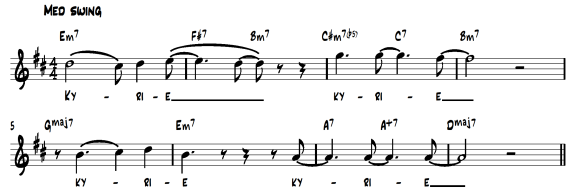Music has often been described with linguistic terms – some would even go as far as to call it a language. Despite its apparent differences between verbal language, it still uses a syntax, a (melodic) vocabulary, phrasing structure, phonology, and many other shared systems. In this blog post, I will show one way that my piece will convey and represent: extroversive semiosis.
Kofi Agawu, using Roman Jakobson’s linguistic approach to semiotics, described extroversive semiosis as anything in music that “denotes external, extramusical, referential connection” (Agawu 1991, 132). An example he gave was that if there was a reference to a style or aesthetic, the music would be referring to a reconetextualised historical style where the style is outside the domain of the piece; my own macro (rather than specific) example is my composition’s reference to Jazz and sacred aesthetics, as well as their historical relationship with each other. Also, the above tapestry refers to an Ancient Egyptian event in time, a reference outside of the materials, colours, and textures of the tapestry itself.
A micro example would be the use of fugal technique in the Kyrie part of my mass. I begin with a reharmonised and paraphrased tune of For the Beauty of the Earth by Conrad Kocher (1967), sung by the first sopranos:
The first sopranos carry on in counterpoint to the second sopranos, where the harmony modulates briefly to the dominant – the theme is again paraphrased:

There are four more introductions of voices with harmonic, melodic, and rhythmic alterations to the original theme, after which the brass section also plays an altered version of the theme. The stimulus for this process was the six days of creation – six introductions of voices – and a seventh rest day – brass soli.
By combining sacred (mass text and hymn material), art music (fugue), and jazz techniques (concerted voicing [potentially a combination of close 4 and drop-2 voicing], reharmonisation, and paraphrasing), the music is not only intended to signify the first part of Genesis. Once an audience-member recognizes a relationship between the styles within the music, they are given an opportunity to connect/ correlate this with the historical relationship between the different styles – in this case, when the styles have interacted cohesively.
Now, how the audience interprets the actual sounds is another matter; it is possible that they do not interpret two signified elements (Genesis and the historical relationship between sacred music/ art music/ jazz) as they were used in the compositional process. The point is that the combination of different signified elements is what developed the compositional process, not to affirm the autonomy of the semiotic elements in this piece.
Previously I wrote about the polydoxy of musical purpose, which is also what I plan to convey and critique in this composition. The intention is to display multiple ‘ideas’ within a realm, where the ‘ideas’ are the signified elements in the music and the realm is the compositional material. Jazz, sacred music, and art music aesthetics are chosen for this piece because a microcosm of musical polydoxy is presented for listeners to review musical polydoxy. Therefore, the use of polysemiotic representationalism is a musical application of the polydox.
In my next post, I will discuss the use of Kofi Agawu’s ‘introversive semiosis’ in my composition, as well as the malleability and convergence of Agawu’s semiotic terms.
Bibliography
Agawu, Kofi. 1991. Playing with Signs: A Semiotic Interpretation of Classic Music. Princeton: Princeton University Press.
Kocher, Conrad. 1967. “For the Beauty of the Earth.” In Favorite Hymns of Praise, 457. Wheaton: Hope Publishing Company.

